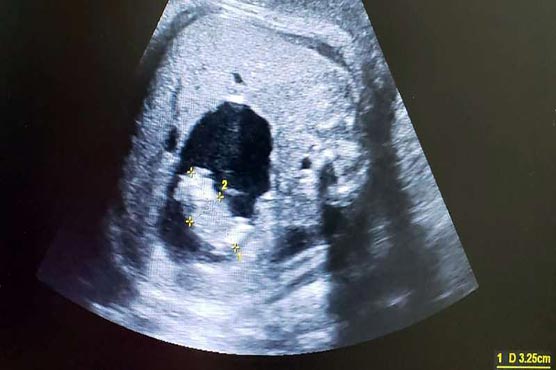Woman gives birth to a twin inside another twin

It is a one in every 500,000 births chance described by British medical journal in 1808.
(Web Desk) - A Colombian woman gave birth to a baby whose abdomen contained her still growing, tiny and half formed twin sister on Thursday.
This type of birth, an example of “fetus-in-fetu,” is very rare but not unprecedented.
Similar births have been witnessed in India, Indonesia and Singapore. It is a one in every 500,000 births chance described by British medical journal in 1808.
This case was unorthodox as the high-risk pregnancy specialist Dr. Miguel Parra-Saavedra identified it during the woman s pregnancy.
He believed that the mother, Monica Vega had a liver cyst in her fetus in her 35th week of pregnancy. Using the color doppler amd 3D/4D ultrasound imaging where she saw the that the fluid-filled space actually contained a minuscule infant, supported by a separate umbilical cord drawing blood where it connected to the larger twin’s intestine.
“I told the mother, and she said, ‘What? No, doctor, this is impossible,’" Dr. Parra-Saavedra said. “But I explained step by step, and she understood.”
He alerted a local television news network, which followed Mrs. Vega, who is now 33, through the birth of her daughter, Itzamara, and the surgery to remove Itzamara’s partially formed twin.
When Itzamara was at 37 weeks and weighed about seven pounds, doctors decided to deliver her by cesarean section, because they feared the internal twin would crush her abdominal organs.
The next day, they removed the fetal twin by laparoscopic surgery. It was about two inches long and had a rudimentary head and limbs, but lacked a brain and heart, Dr. Parra-Saavedra said.
Fetus-in-fetu is sometimes misdiagnosed as a teratoma, a tumor that may contain bones, muscle tissue and hair. A DNA comparison is being done, but Dr. Parra-Saavedra has no doubt that the fetuses started out as identical twins from the same ovum.
Because the smaller fetus took nourishment from its sibling, it is called a heteropagus or parasitic twin.
Some heteropagus twins are born conjoined to their healthy siblings, while some grow partially inside and partially outside their twin’s body.
Doctors believe that in exceedingly rare cases, the twin embryos only partially divide, and the larger one wraps around the smaller.
The condition may go undetected for many years.
Itzamara is doing well, Dr. Parra-Saavedra said. “She has a little scar on her abdomen, but she is a normal baby now except that the whole world is talking about her.”


